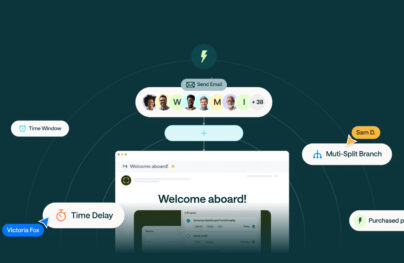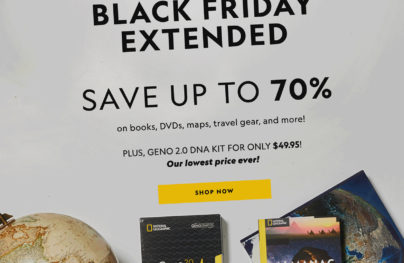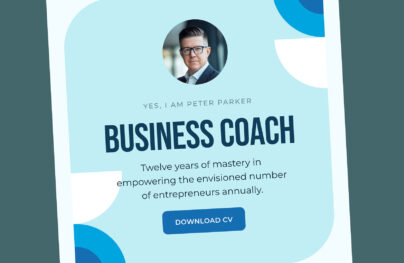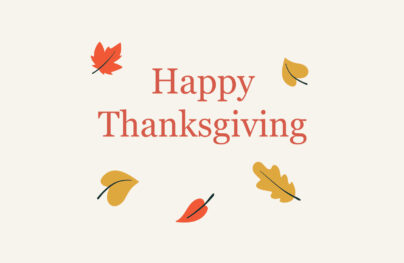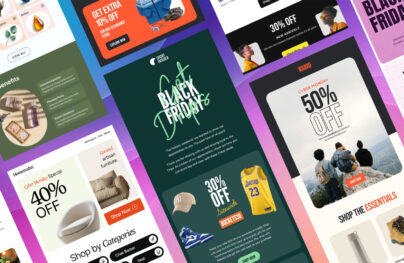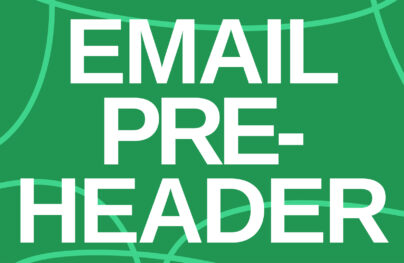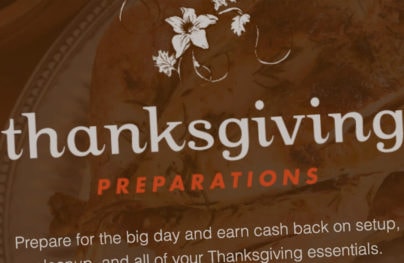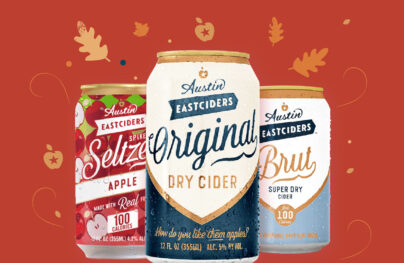B2C Email Marketing Guide: Best Strategies, Ideas and Examples
B2C email marketing is one of the most powerful tools for businesses to connect directly with customers. With over 4 billion daily email users worldwide, email marketing allows brands to deliver personalized experiences, boost engagement, and drive sales—all while nurturing long-term customer loyalty. Whether you’re an established business or just starting, mastering B2C email marketing can unlock new opportunities and ensure your messages resonate with your audience, leading to meaningful and measurable results.
Do you know that 81% of businesses use email as part of their marketing strategy, with a hefty chunk of that in the business-to-consumer sector? This should not surprise you—with 4.48 billion users globally, the reach is immense. A company that directly markets to individual consumers could not help but derive substantial benefits from this well-controlled, hyper-personalized mode of communication.
This year, email marketing will be a core strategy for achieving success for many B2C companies. According to Forbes, over 60% of startups and small businesses find this communication channel an effective, accessible, and affordable way to deliver targeted messages. Half the marketers surveyed believe it is the most powerful channel for generating high engagement and conversion rates.
The direct nature of email opens golden opportunities for B2C marketers to connect with customers on a personal level and encourage repeat business. Though, it can do much more than that, playing a crucial role in today’s survival. Follow our guide to B2C email marketing, where we will uncover the best strategies and ideas for high-converting campaigns and examine some of the best B2C email newsletter examples.
What Is B2C Email Marketing?
First things first—what is B2C email marketing? B2C email marketing is digital email communication between a company and consumers. It entails sending digital newsletters directly to individuals or households. It involves techniques and strategies to promote the company, inform about products and services, and build brand identity.
The main distinctions that separate B2C email marketing from B2B email marketing are:
With Postcards Email Builder you can create and edit email templates online without any coding skills! Includes more than 100 components to help you create custom emails templates faster than ever before.
Free Email BuilderFree Email Templates- Emails drive immediate actions as B2C companies have a short sales cycle.
- Email campaigns deliver hyper-personalized body content that connects with a subscriber on an emotional level.
- Emails are mobile-optimized, as most individuals prefer to read personal correspondence on their cell phones.
- Emails have attention-grabbing subject lines and preheader text that compel immediate action.
- Email campaigns prioritize visual aesthetics, first impressions, and creativity by introducing visual elements, brand identity, high-quality images, eye-catching call-to-action buttons, etc.
Email marketers employ different types of digital newsletters. Some of the most popular are:
- Welcome emails. They reach subscribers who first signed up to a mailing list.
- Onboarding emails. They assist and guide users after they have initially engaged with a brand.
- Promotional emails. They introduce new products and increase the brand’s awareness and interest.
- Sales emails. They notify about special offers, limited-time deals, or exclusive content.
- Informational emails. They serve different purposes, from educating customers by sharing relevant content to nurturing clients and reinforcing relationships.
- Transactional emails. They are triggered and sent in response to a user’s action on a website or application. Representative examples include abandoned cart notifications, order confirmation emails, password reset emails, payment receipt emails, and confirmation emails.
- Reminder emails. They are a separate group of transactional emails triggered by a user’s inactivity. They notify customers about important deadlines and encourage them to act.
- Re-engagement emails. They reach inactive customers to win them back and re-open dialogue.

Typical B2C email (Warrd Email Template by Designmodo)
Importance of B2C Email Marketing
Recent surveys indicate that B2C email marketing is crucial to a company’s success. It has a proven return on investment and effectiveness in driving sales. Nearly 90% of respondents plan to maintain and even increase their spending on email campaigns. Here are some reasons why.
It connects with receptive consumers
Connecting with a receptive target audience is perhaps one of the most important reasons to introduce email marketing. Unlike advertising and social media, email marketing connects businesses with consumers who willingly signed up for newsletters and demonstrated their interest in the company, offer, or product.
These consumers are likely to receive your emails positively and interact and engage with the content more enthusiastically, which opens golden opportunities for growth.
It meets the target audience’s expectations
Another important reason for adopting B2C email marketing is to meet current audience expectations. The recent Sinch Mailgun survey revealed that over 75% of consumers chose email as a preferred channel for receiving promotional messages. According to the report, they prefer and expect emails because they believe they receive the most value from a brand this way.
It has a low barrier to entry
Email marketing is famous for its ability to reach a large target audience, promote products, nurture clients down the funnel, and build brand loyalty without large budgets. Many email marketing platforms offer free or low-cost plans, and with Postcards email builder, you can craft professionally-looking digital newsletters within minutes without any dev team.
It is cost-effective
Unlike other marketing channels, email marketing reigns supreme regarding return on investment. Multiple studies show it returns between $36 and $40 for every dollar spent, making it a wise investment.
With Startup App and Slides App you can build unlimited websites using the online website editor which includes ready-made designed and coded elements, templates and themes.
Try Startup App Try Slides AppOther ProductsIt is easy to handle
Email marketing is easy to start immediately and maintain along the way. You only need a reliable ESP and an intuitive email builder like Postcards. These powerful tools have a minimal learning curve and do not require any technical or design skills. Any startup may enter the game immediately and unlock the potential of direct communication with the target audience.
It helps track customer engagement and measure campaign success with precision
What are companies without accurately measuring their progress? You cannot deal with your weaknesses without properly understanding how well or poorly you are doing on the market. This deprives you of an opportunity to introduce much-needed improvements to move forward. Email marketing allows B2C companies to track customer engagement and measure campaign performance, which is crucial for informed decisions.
Benefits of B2C Email Marketing
One of the main benefits of using B2C email marketing is that it assists companies in growth and development regardless of their scale, age, niche, target audience, and product.
Another benefit of extending the primary marketing strategy over email channels is that they open doors to global reach. Even if you do not intend to conquer other regions now, having an opportunity to reach an international audience instantly without any extra expenses and effort lets you create a long-term strategy and underlie a solid foundation for future growth.
Building a strong brand identity is another advantage of B2C email marketing. Well-designed and brand-consistent email campaigns allow companies to showcase their visual identity and reveal their vision, mission, and ideology. They reinforce a cohesive brand image in subscribers’ minds and create a united front on the market.
Another benefit is creating strong and lasting relationships with the fan base. B2C email marketing delivers value at the right time to the right person through hyper-personalized emails and cadence, thereby increasing satisfaction with the brand and building trust and loyalty. These factors gradually translate into healthy relationships with customers, who are more likely to engage with and interact with the brand’s newsletters and offers.
Increased sales are also among the substantial benefits of B2C email marketing. Effective email marketing campaigns that nurture customers down the funnel increase conversions and ultimately drive sales and repeat purchases.
Finally, email marketing helps companies better understand customers’ needs, preferences, and expectations. Businesses gain valuable insights into customers’ habits and demands by tracking crucial email campaign performance metrics like open rates, conversions, deliverability rates, and spam complaints.

B2C Email Marketing Statistics
To fully understand the impact and potential of B2C email marketing, it’s essential to look at the data. Here are some key statistics that highlight why email remains a dominant force in digital marketing:
- Global Reach: In 2023, the number of email users worldwide surpassed 4.37 billion, with projections suggesting it will grow to 4.6 billion by 2025. This sheer volume of users provides a significant opportunity for B2C businesses to connect with their audience directly.
- Outstanding ROI: Email marketing offers one of the highest returns on investment (ROI) across all marketing channels. For every dollar spent, businesses see an average ROI of $36, making it one of the most cost-effective marketing strategies available today.
- Consumer Behavior: Studies show that 58% of consumers check their email first thing in the morning, underscoring the importance of email as a primary communication tool in daily life. Additionally, nearly 60% of customers prefer to receive brand updates via email compared to other channels.
- Personalization Pays Off: Personalized email campaigns have an average open rate of 26%, compared to non-personalized emails, which typically see an open rate of around 20%. This demonstrates the value of crafting tailored messages that speak directly to consumer needs and preferences.
- Mobile Dominance: As mobile devices dominate, over 60% of all email opens happen on mobile. This trend emphasizes the need for mobile-friendly designs and responsive email templates to ensure that messages are easy to read on the go.
- Conversion Power: Email marketing outperforms other digital channels in terms of sales, boasting an average conversion rate of 3.2%—higher than social media and paid search.
- Recovery Through Abandoned Cart Emails: One of the most effective email tactics for eCommerce businesses is abandoned cart recovery emails. These emails have an impressive open rate of 45% and can recover up to 11% of abandoned carts, substantially boosting revenue.
These statistics showcase the power of B2C email marketing and highlight the importance of using data-driven strategies to optimize campaign performance. Email marketing remains a cornerstone of successful digital marketing efforts, whether you’re seeking to boost engagement, increase sales, or build long-term customer relationships.
Challenges of B2C Email Marketing
Providing low-cost services, a quick implementation process, or a solution to a common pain point, businesses in the B2C sector are famous for their short sales cycle that generates revenue quickly. However, it poses a true challenge for email marketing.
A short sales cycle is characterized by a swift progression from lead generation to closed deals. It requires companies to offer a service or product to an accurately defined, motivated target audience with a rapid decision-making process. Accommodating it in email marketing could be difficult.
Email marketing is an ongoing process that gradually warms up and nurtures subscribers to build rapport, eventually leading them down the funnel and conversions. Companies should constantly track customer’s preferences and trends to understand their current needs and pain points. Companies need to perfect segmentation to identify qualified leads. Finally, companies need hyper-personalization to provide concise, compelling offers that encourage immediate deals.
Providing hyper-personalization is another big challenge in B2C email marketing. Although customers expect to receive individualized content and offers, they are unwilling to share their personal information, needs, and preferences. They may even prohibit companies from tracking their activity on websites and emails, making gaining valuable insights into their current demands and habits difficult.
The way out is to promote transparency in communication and use surveys, reviews, and feedback to gauge data.
The last great challenge in B2C email marketing lies in companies’ inability to adapt quickly to ever-changing customers’ preferences and needs. Reasons for that vary. Some companies lack the necessary resources or knowledge, while others fear embracing change. However, staying on top of things is crucial for email marketing success. If you send irrelevant emails, you lose customers, money, and a hardly-earned brand reputation.
B2C Email Marketing Best Strategies
Developing a B2C email marketing strategy is perhaps one of the most critical steps in achieving a successful presence in the communication channel. It helps companies set the right short-term and long-term objectives, wisely allocate resources, sync actions with brand identity, and amplify efforts across campaigns. Eventually, this will generate brand awareness, conversions, and leads.
Let’s consider the best B2C email marketing strategies that use different types of digital newsletters to address essential buyer stages.
Start with Welcome Emails to Make the First Impression Count
Serving as the doorway to your brand, welcome emails underlie a solid foundation for future relationships. They make that first impression count and build upon the effect produced by your product or website, which has compelled customers to join your mailing list.
According to Campaign Monitor, welcome emails are “welcome,” with an overwhelming 68.6% open rate. Nearly 3 out of 4 respondents said they expect to receive this kind of digital content and read rather than scan it. This opens golden opportunities for businesses.
First, they might introduce new subscribers to the brand’s services, products, values, and mission.
Second, they might create brand loyalty and promote transparency by clearly stating what to expect.
Third, they might guide subscribers to the first purchase.
Finally, they might secure the long-term brand engagement.
Here are some tips to make it work for you:
- Use automation tools to reach your new subscribers within 48 hours.
- Inform about your social media accounts, contact methods, and physical address.
- Invite them to the preference center, where they get total control of their email experience.
- Demonstrate what makes your brand unique.
- Show your appreciation by saying thank you and including a coupon, welcome offer, or exclusive preview.

Bridge the Gap with Onboarding Emails
Whether you send welcome emails or not, initiating an onboarding email sequence is the critical first step in laying the foundation for a meaningful relationship with your customers. It bridges the gap between the company and the target audience and breaks the ice with newcomers.
While welcome emails are widely considered an introduction to the business through heart-warming greetings, onboarding emails are more technical communication that provides customers with the necessary knowledge to navigate the brand and product successfully.
Many companies use onboarding emails for these purposes:
- Give necessary resources to take advantage of their offerings.
- Improve customer experience by providing direct points of contact.
- Recommend additional services or products to address customer’s pain points effectively.
- Gather relevant insights and get to know the customer better.
- Explain why the company or product is worth the customer’s attention through social proof and user-generated content.
Here are some tips to nail this strategy:
- Develop a sequence of interconnected branded onboarding emails.
- Go for multiple targeted onboarding campaigns with behavior-based emails.
- Produce a seamless, cross-channel experience by aligning onboarding emails to in-app or website messaging.
- A/B test and measure the overall success of email campaigns.

Offer Incentives Through Promotional Emails
Promotional emails are the heavy weaponry of B2C email marketing. They speed up the buying process, drive sales, and encourage contacts to take some action, like registering for an event or starting a trial. They underlie a solid foundation for the “convincing” game and amplify efforts to generate much-needed traffic and leads.
Initially, promotional emails inform subscribers about new products or updated features. However, their scope of usage is quite wide and diverse. Companies introduce them in their email marketing campaigns to do these tasks:
- Get the word about special offers, limited-time deals, or exclusive content.
- Announce contests to generate traffic and drive subscriber engagement.
- Offer free content or materials like e-books, reports, or a video training series.
- Promote new informational content, such as a blog, guide, tutorial, or video post.
- Announce the company’s event.
- Invite to take a free trial of a program or software.
- Align with seasonal or holiday marketing strategy.
Promotional emails are the driving force of B2C email marketing. Follow these best practices to maximize their effect:
- Conduct thorough segmentation of the mailing list to create targeted email campaigns.
- Personalize email subject line, preheader text, content, and offer.
- Authenticate each email by setting DKIM, DMARC, and SPF records.
- Optimize for mobile devices, email providers, and operating systems.
- Determine the right cadence and sequence for each market segment.
- Create professional and high-converting email designs in Postcards.

Nurture Customers with Informative Emails
Besides driving sales, companies widely use email channels to turn customers into loyal brand advocates. Informative emails enter the game and offer reliable tools to implement this tactic. They are used to do these tasks:
- Introduce subscribers to the company’s inner world and culture by revealing their vision, mission, values, and ideology.
- Address customer pain points by helping through guides, tutorials, listicles, and recommendations.
- Give food for thought and unobtrusively remind about the company and its place in the customer’s lifestyle.
- Build a strong social position in the eyes of subscribers.
- Inform customers about new developments in the niche, company, or product.
Informative emails come in all shapes and sizes, from short announcements to long-reads. When introducing them in your B2C email marketing routine, follow these tips:
- Be clear and concise and get to the point, avoiding secrecy, vagueness, or mystery.
- Make them useful and relevant to customer’s preferences and needs.
- Use appropriate language.
- Exercise caution with emotions.
- Format the copy to ensure optimal readability level.
- Make emails accessible and inclusive across devices, screen sizes, and mailbox providers.

Informative email from Salesforce
Build Excellent Customer Experience through Transactional Emails
Transactional emails represent the biggest and most diverse group of digital newsletters. Triggered by certain users’ actions or, on the contrary, inactivity, they are automated blasts, reminders, and notifications that communicate on-timely important information and updates necessary to address current customers’ pain points. They supervise these essential processes:
- Order Confirmation
- Finalization of the deal
- Shipping
- Delivery confirmation
- Double opt-in
- Password reset
- Legal update
- Security concerns
- Invoice creation, etc.
Transactional emails are almost invisible assistants whose job is usually done in the background. They are always taken for granted. However, an excellent customer experience could not happen without them. They are the most valuable messages that hit users’ inboxes in many situations. They take care of business and customers and keep things working. They are so important that they can be seen in most professional B2C email marketing strategies.
Here are some good reasons to introduce them in your routine:
- They are highly anticipated. Studies show that people expect to receive transactional emails (like password recovery or shipping confirmation) from brands immediately after requesting them.
- They are personal. Unlike most digital newsletters, they are never sent in bulk. Each letter is hyper-personalized, targeted at a specific situation, and contains information unique to the recipient.
- They are relevant. Transactional email often includes time-sensitive information and delivers solutions on time.
- They address current pain points. In most cases, they bring a message connected to something the customer needs to solve.
Let’s consider one of the most popular and effective B2C email marketing strategies based on abandoned cart notifications.
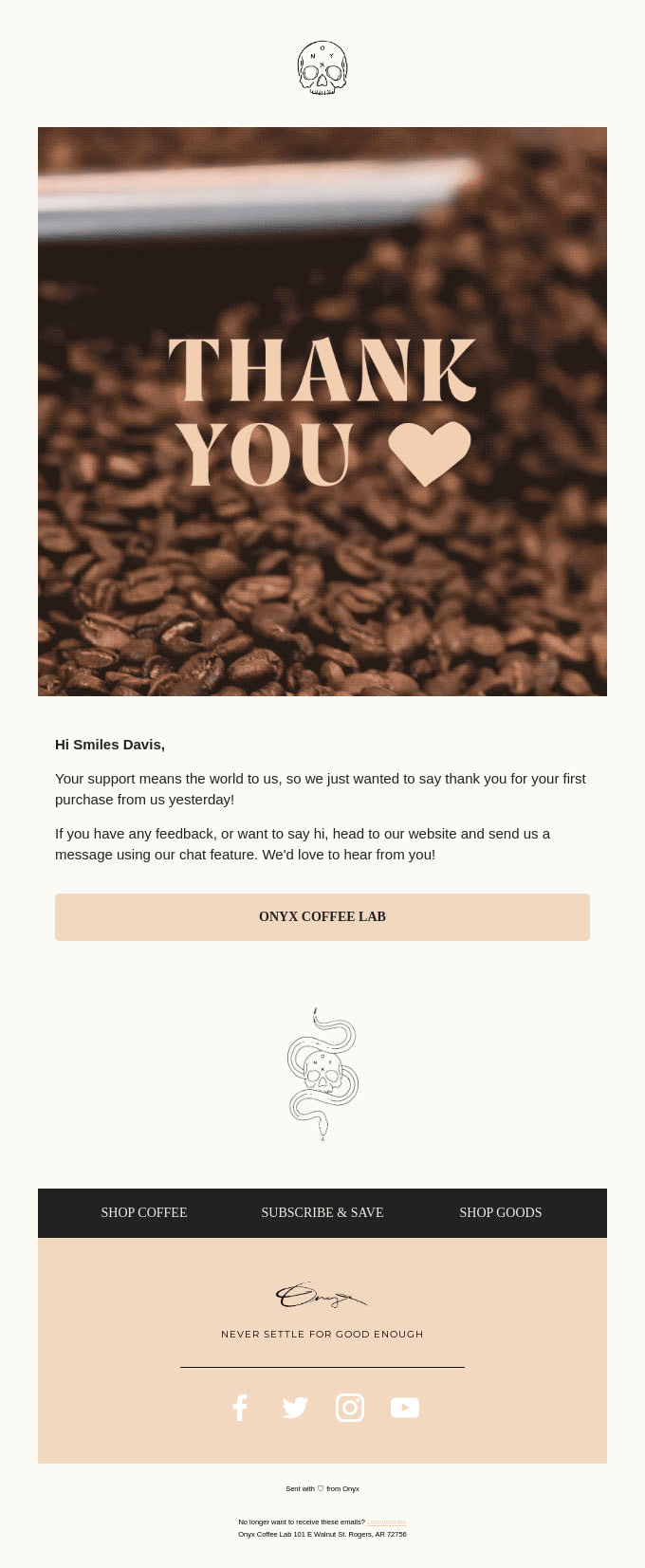
Transactional email from Onyx Coffee Lab
Abandoned Cart Notification Tactic
Customers adding products to the cart but leaving before closing the deal is common for B2C companies. Recent studies by Baymard Institute showed that the average cart abandonment rate is almost 70%.
However, that does not mean you cannot improve the situation. In addition to enhancing your storefront and involving the customer support team, you may set up a cart abandonment workflow in the email channel. This tactic has some great advantages over other methods of communication.
- It offers plenty of room to maneuver. You may create as many abandoned cart notifications as you need to bring customers back.
- It is flexible and extendable. You may add the complete details of abandoned orders, including an image preview, the product name, price, and reviews.
- It is cost-effective. Transactional emails are part of automated email marketing and are usually covered by ESP plans. So, you can re-engage customers without breaking the bank.
- It is automated, hyper-personalized, and timely. Professional email service providers have all the necessary tools to automate and individualize transactional flows.
- It could be enforced by other types of emails. For instance, you may reinforce abandoned cart notifications with promo blasts and special discounts or incentives.
Here are some tips to make it work for you.
Create an abandoned cart recovery sequence.
Start slow and low by sending two to three messages. Remind customers about products left in the cart. Then, provide incentives to compel them to finalize the deal. Finally, take a last chance and play psychological tricks like FOMO or exclusivity to win them back.
Determine the best time to implement the strategy.
Unlike most transactional emails, abandoned cart notifications may wait until the right time. Analyze your customers’ behavior patterns to determine the best time and day of the week when they are more likely to engage with your brand and offer.
Come up with an engaging subject line and preheader text.
Do not hesitate to use the same language to demonstrate the brand’s personality and appeal to your customers. Emojis, action words, and compelling phrases that might spark curiosity may be of benefit.
Perfect email content and design.
Start with content: add a special offer or discount based on the abandoned cart value and mention related products to grab an upselling opportunity. Personalize messages to speak directly to the recipient and provide value that resonates with their preferences and purchase history.
You may try incorporating a sense of urgency, scarcity, or exclusivity, but never push. Abandoned cart notifications are powerful in what they can do but have a detrimental impact when overused. If you want to boost customer confidence in the value of left products, it is better to use social proof in the form of positive reviews, testimonials, or ratings.
Finally, craft visually appealing, mobile-optimized designs in Postcards.

Abandoned cart notification from Sonos
Save Relationships with Re-engagement Email Campaigns
Re-engagement B2C email marketing strategies are powerful instruments in a company’s arsenal. They are designed to revive relationships with subscribers who have gone cold, increase engagement rates, and boost sales. They are important for businesses because they are cost-effective ways to ensure repeat purchases and prolong customers’ lifecycles.
Re-engagement campaigns entail reaching inactive subscribers with targeted messages or incentives to encourage them to initiate dialogue with the company. They are used to compel consumers to act:
- Make a purchase
- Start a trial
- Get acquainted with new products or features
- Attend an event
- Sign up for a service
- Visit the company’s website
When rightly implemented, a re-engagement email strategy drives engagement, increases traffic, amplifies conversions, and ultimately brings revenue.
Apart from that, businesses often use this strategy to clean up their mailing lists and get valuable insight into why subscribers disengaged in the first place. By sending surveys or asking for feedback, they gain relevant and valuable knowledge to improve communication and cater to audience needs.
Follow these best practices to make this strategy work for you:
- Go through your mailing list to identify and segment inactive subscribers.
- Examine purchase history to define behavior patterns, preferences, and needs. This knowledge helps to craft the right content for each individual.
- Conduct RFM analysis. Explore the recency, frequency, and lifetime value of lapsed customers.
- Create a compelling subject line, preferably with an offer or incentive.
- Determine the right email cadence.
- Design branded and visually appealing re-engagement emails.
- Try a sequence, but avoid being pushy, bossy, or noisy.
Finally, add an unsubscribe option. This is perhaps one of the most critical elements of a re-engagement B2C email marketing campaign. It will prevent spam, complaints, and blacklisting and ensure you meet current laws and regulations.

Define a Customer Journey for Your B2C Email Marketing Strategy
Creating B2C email marketing for each customer lifecycle stage is the best way to achieve success in the channel. By sending subscribers the right message at the right time, you nurture them into the funnel, drive engagement, generate conversions, and secure revenue. To do this, companies should master the customer journey.
The customer journey is a series of steps that lead to purchase. However, it is not the linear story of a consumer encountering your brand and gradually moving from prospect to lead. This bumpy path involves obstacles, stepbacks, and wrong directions. Businesses must think through every interaction, step, and stage in B2C email marketing to emerge victorious.
Here are five essential stages of the customer journey that companies should address with the correct strategy.
Acquisition stage
The customer has learned about your brand and signed up for your mailing list. The time has come to make the first impression count and introduce your company in the best possible light. To this end, companies may send heart-warming welcome emails or initiate informative and educational onboarding series.
Consideration stage
This phase involves customers researching and gaining valuable insights into whether your company or product is what they need to address their pain points. Businesses should move customers toward the brand and encourage further engagement. This implies sending emails with social proof, educating them about the product’s benefits, and personalizing abandoned cart notifications.
Purchase stage
This is perhaps one of the most critical phases, as you must ensure everything is perfect. The company should provide support at every step and ensure transparency during the transaction. This involves sending order notifications, shipping notifications, invoices, thank-you notes, and product follow-up emails.
Re-engagement or Retention stage
Re-engagement is a dark horse of email marketing. It is regularly overlooked but substantially benefits the company by keeping customers in the loop or winning back lapsed ones. Businesses adopt various tactics – they offer loyalty perks, notify about arrivals, remind about their importance, say hello, or send a regret email.
Advocacy stage
This phase is the last and undeniably the hardest to nail. However, it opens a golden opportunity for the company to turn one-time buyers into loyal, repetitive customers and brand advocates.
The best advocacy strategy is to be proactive with follow-up communications in the email channel. Companies may send personalized discounts, reward subscribers with a bonus program, acknowledge important dates, offer an exclusive preview of a new product, or ask for feedback.
The process is daunting, resource- and time-consuming, and requires company commitment and devotion, but it is worth it, as it maximizes presence in the email channel.
B2C Email Marketing Best Practices and High-Converting Ideas
What B2C email marketing strategy should you adopt for your current state of business? There is no one-size-fits-all solution. Some companies throw every tactic in the mix, while others stick to several options.
Either way, here are some of the best B2C email marketing practices and ideas that should help you achieve your ultimate goals in the channel. Follow them to maintain a natural pace with your subscribers so they will not feel overwhelmed or exhausted by your communications.
Adopt Double Opt-in Registration
Adopting a double opt-in registration process is perhaps one of the first critical steps your company should take when entering the email channel game. It entails validating the contact information before adding it to the list by sending a confirmation email to the address left by potential subscribers in the sign-up form. While it may slow down the acquisition process and even scare away some contacts, it has proved to be increasingly important for your company for these good reasons:
- It is proof of consent for every contact in your database. This means you obey international laws and regulations, such as GDPR and the CAN-SPAM Act.
- It guarantees that your list has only valid contacts. Providing an extra layer of protection against fake or mistyped email addresses saves you from issues related to typos in the sign-up form.
- It ensures your mailing list has readers who are initially engaged and interested in the brand and content. With a confirmation letter, you will avoid all those who submit email addresses that do not belong to them or are rarely checked.
- It builds healthy relationships with customers from the start. By seeking the user’s consent, you demonstrate your socially responsible position and respect for customers. This level of transparency inspires trust, credibility, and loyalty.
- It improves key email performance metrics. By avoiding fake addresses, you potentially minimize bounce rate, unsubscribe rate, complaint rate, and blacklisting.
Introducing a double opt-in system is just a small step, but it is crucial for establishing a solid foundation for your marketing strategy in the channel. Follow these simple yet helpful tips:
- Create a protected sign-up form. Add Captcha and validate the email address before submission.
- Make the process clear. Tell your subscribers what to expect when joining your mailing list and clearly state that further action (confirmation of contact address) is required.
- Send a confirmation email immediately. Make it compact and concise to reduce friction and inspire action.
- Think through the opt-in confirmation page.
- Always say thank you.

A confirmation email from Catch
Authenticate Emails
Regardless of email type, it needs to be properly authenticated. With new Google and Yahoo updates on security measures that have already come into force, this best practice should be highly prioritized. Otherwise, you will face a drastic rise in bounce rates, as these industry goliaths will reject all digital correspondence without proper authentication.
Authentication is verifying the origin and legitimacy of the message and sender. Its goal is to help the receiving server identify faked or forged correspondence and create a safe user environment.
Several widely adopted security protocols underlie authentication in email channels. They are SPF, DKIM, DMARC, ARC, and BIMI. Each one is responsible for its area. For instance, SPF helps to recognize impersonated domains used by bad actors, whereas DKIM verifies that the message and attachments were not altered in transit.
By adopting this practice, you protect your brand by mitigating spam and phishing. You also signal to mailbox providers and ESPs that you meet security requirements and respect your recipients. This builds a strong reputation for your brand, which leads to a high sender score and improved deliverability.
To get started with authentication, check out our Email Deliverability Guide: Best Practices and Tools to Avoid Spam Folders.
Use the Best Tools for B2C Email Marketing
Choosing the right tools is not just a matter of convenience or personal preference; it directly impacts the ability to unlock the true potential of B2C email marketing. It enhances productivity and gives the company a fighting chance to stay competitive. Here are the most critical tools that you should have in your arsenal:
- Email marketing platform. It is a driving force for most of the channel’s strategies and tactics.
- Email template builder. It allows companies to bring their email marketing ideas to life.
- Analytics tool. It provides valuable data insights to make informed marketing decisions.
- Email spam checker and deliverability test. It surfaces opportunities for improvement.
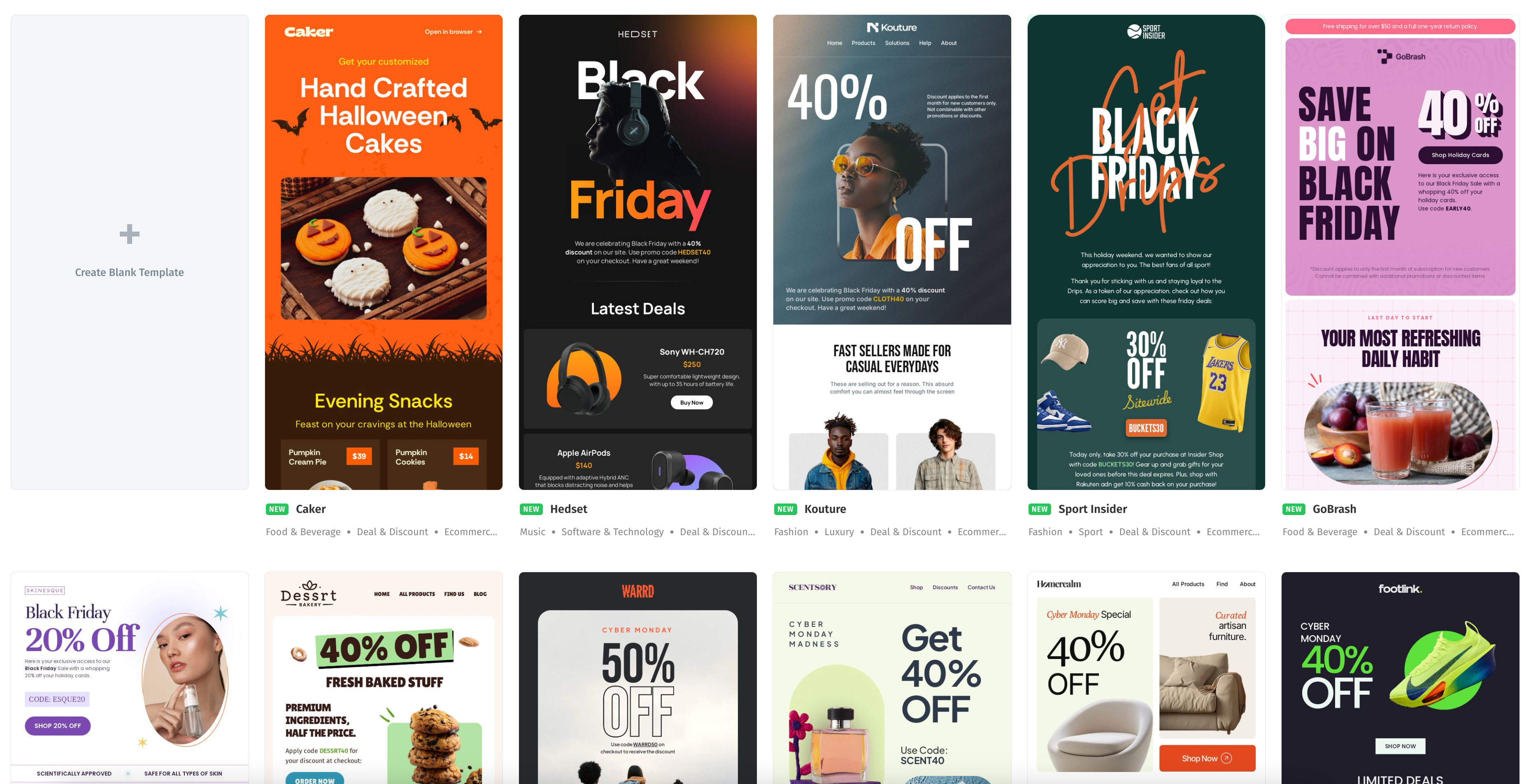
Postcards – the best email builder
Monitor and Reinforce the Sender’s Reputation
Monitoring and reinforcing your sender’s reputation are other highly recommended practices. Coming as a critical factor that may easily nullify your email marketing efforts, it calls for special attention.
Sender reputation is a score assigned by email service platforms and mailbox providers. It determines a company’s credibility and reflects email campaigns’ trustworthiness and quality. The higher it is, the more likely emails reach their destination. Conversely, a low sender score results not only in a high bounce rate but account suspension and blacklisting.
Follow these basic tips to ensure it is high and positive:
- Authenticate your emails.
- Clean up your mailing list.
- Reduce bounce rate and spam complaints.
- Comply with email regulations.
- Check out blacklists.
- Improve engagement by adopting the best practices for email design and content.
- Monitor your sender score and address issues.
- Invest in a reliable email service provider.
Align Lead Generation Strategy with Email Marketing
A B2C company is nothing without a constant flow of qualified leads. Not only do they bring revenue, but they also underlie the company’s growth, development, and achievement of long-term goals. It is crucial to map out a strong lead generation strategy perfectly aligned with email marketing.
Lead generation entails acquiring and working with engaged and responsive subscribers to build visibility, credibility, trust, and interest. So, start by onboarding only those consumers who are genuinely engaged and interested in the company’s content, product, and identity. While a double opt-in system may help, that is not enough. It is important to adopt practices that attract the right crowd from websites and applications.
Here, it would be best to exercise caution with tactics such as contests or giveaways. While they might increase your mailing list overnight, you risk getting contacts who are not deeply engaged with the brand. Therefore, create a special segment for those subscribers and work with them separately.
Another important step is to keep monitoring and optimizing your lead generation strategy. Inspect your email campaigns and assess their efficacy. Conduct A/B tests and use automation to improve results.
Finally, message, theme, and activity consistency across channels should be promoted. For instance, if you run holiday contests on social media, ensure your email campaign notifies subscribers about that using thematic email design and copy.
Maintain a Strong and Healthy Mailing List
A regularly replenished mailing list is the lifeblood of any business in the B2C sector. It opens doors to direct outreach for the right audience, offers personalization opportunities, reinforces brand reputation, and amplifies overall revenue. Every company dreams of having a big subscription list, but this does not mean quantity should be prioritized over quality.
As anything, high-converting B2C email marketing is based on delivering the right message to the right person. Whatever tempting it is to increase your mailing list over the night by purchasing it from third parties, always avoid that. First, you risk cluttering your list with junk (fake addresses, honeytraps, or disengaged contacts). Second, when caught, you may face blacklisting and account suspicion, which leads to halting your activity in the email channel.
Instead, follow these recommendations to build up a strong and healthy mailing list through “white” practices:
- Use a double opt-in system.
- Deliver value with each outreach.
- Listen to your subscribers and address complaints right away.
- Provide a clear, simple, and quick unsubscribe option in every digital newsletter.
- Segment list based on relevant criteria.
- Use compelling incentives with caution.
- Validate email addresses.
- Clean up and segment subscription lists regularly.
- Introduce re-engagement campaigns to leads that have gone silent for a while.
- Group soft-bounced contacts and work with them separately.
- Delete hard-bounced contacts immediately.
Practice Personalized Outreach
The importance of personalized outreach in B2C email marketing is hard to underestimate. First, the company intends to consider its customers as people, not buying personas. Second, it reaches customers with relevant messages and value. Third, it secures the best time and deliverability for better interaction. Finally, it results in high engagement rates, conversions, and leads.
Originally, personalization meant tailoring an email’s content to a specific contact based on their demographics, professional background, habits, behavior patterns, purchase history, and other factors. However, nowadays, it is much more than that.
Modern-day personalization entails personalized outreach. This involves crafting tailored emails and determining the right cadence for each individual. At a minimum, adopt these solutions:
- Define the right time and day of the week to reach subscribers.
- Determine the right sequence.
- Address contact by their name.
- Create a personalized subject line.
- Insert specific product recommendations.
- Offer customer-targeted discounts.
- Call out something customers may be looking for on a website.
Invest in Email Design
It is not enough for your emails to come at the right time with the right message. It is also crucial to make the right impression, provide a lasting user experience, make the most of the customer’s short attention span, and ensure consistency in message and brand identity delivery. Email design can do all these.
Email design comes of huge importance in creating high-converting email campaigns. It affects email engagement, sales, satisfaction, and loyalty and does lots of crucial tasks like
- Creating a professional look and feel for digital communication.
- Presenting information in an accessible and easy-to-understand manner.
- Promoting brand identity.
- Influencing the decision-making process by strategically placing offers and call-to-action buttons.
- Reinforcing brand recognition.
- Increasing trust and credibility.
Crafting an email design that will serve its purpose correctly could be tricky, as email development has many challenges. The best solution is to use Postcards, a professional email builder. It does all the heavy lifting regarding the coding part, leaving users with an intuitive drag-and-drop interface to craft any email design they want in minutes. It also has a fantastic collection of pre-made templates so companies can jump-start their email campaigns immediately.
Other recommendations
We have featured the principal recommendations. However, you can try other clever and effective ideas and tactics in your B2C email marketing strategy that amplify efforts and help companies achieve the desired goal faster and more efficiently. Here are some of them:
- Automate transactional emails and email sequences.
- Keep track of key email performance metrics.
- Create email sequences based on the customer’s cadence.
- Follow trends.
- Introduce seasonal and event email marketing.
- Devise email marketing calendar and plan.
- Do regular email spam checks and deliverability tests.
- Conduct A/B tests.
B2C Email Marketing Best Examples

We will start our collection of the best B2C email marketing examples with Bubble’s email. The company knows how to make the first impression count and establish a solid foundation for healthy and strong relationships with new customers.
Their welcome email hits all the essentials to nail down the acquisition stage. It has a heart-warming greeting that breaks the ice, an eye-catching hero image that brings a smile, a short introduction to the brand’s community, a promo block with recommendations, and all crucial details and links.
The design perfectly aligns with a vibrant brand’s personality, drawing newcomers into its joyful atmosphere. Although the newsletter is big and content-heavy, readability is great thanks to a well-optimized structure. You might quickly scan the content and get all the necessary cues.
It is worth noting that Bubble does not stop its introduction strategy with welcome emails. The team has also initiated an onboarding series to help the customer get to know the brand better and understand how to make the most of this collaboration.


Email from Rael is a bright representative of a B2C email marketing strategy centered around abandoned cart notifications. The team has done its best to bring would-be shoppers back to complete a purchase or revisit the store.
Their abandoned cart email is a subtle nudge that gently entices subscribers into action. It initiates a friendly dialogue without any tension. You may see how the team has strategically positioned an invitation to check out the product left in the cart and supplied a hard-to-miss call-to-action button. They have also added a personalized product recommendations block right in front of the customer as another good reason to visit the website.
The email design creates a warm, discreet, and friendly atmosphere here. It leads customers from top to bottom through all key parts to nurture them down the funnel naturally.

Disney is famous for its unique email campaigns that are rich in personality. Not only does their team know how to introduce brand identity in digital communication, but also how to align it with customer’s moods and create a fantastic and meaningful user experience. This email is a great example of how the company leverages holiday email marketing to play along with the crowd’s feelings and emotions.
Dedicated to Halloween, it screams the holiday on all fronts. There are famous villains, scary visuals, the right festive colors, pumpkin-inspired call-to-action buttons, and scaring typography. Unleashing the power of dynamic approaches, the team has also created an interactive user experience through siders and gamified elements.
As a result, this email is one to remember. The design grabs and maintains attention without much effort, whereas content drives engagement and leaves a long-lasting impression.

If you want to repeat something similar, consider Caker, a free HTML email template by Designmodo. This spooktacular digital newsletter was designed with Halloween in mind. It has everything you need to deliver your message in style and treat your subscribers with genuine content. Its authentic atmosphere naturally drags readers into the festive mood and maximizes the impact of holiday B2C email marketing.

A reward loyalty strategy is among the most powerful instruments in the B2C email marketing arsenal. It reduces churn rates, retains existing customers through incentives, and maximizes repeat purchasing power. The creative team behind Starbucks demonstrates how to use it in an email channel.
The company regularly conducts this type of campaign. Their goal is to remind their customers that they are important to a big community. They use every valid opportunity (including season transitions, holidays, and big local events) to show appreciation through a loyalty program.
This Starbucks email is timed to the first month of fall, infamous for its shifting moods as people return to work after a relaxing summer. The company tries to ease this transition by hinting about all the good times that await. They refresh their memories of some of the best autumn-inspired products and invite them to enjoy a reward program, brightening their days.
The email design exudes warmth and positive vibes. The branding coloring nicely accentuates fall motifs, whereas visuals and imagery create a soothing and welcoming user experience. The message is properly highlighted, with the offer instantly drawing attention.

The email from Vegamour is a typical representative of a sales-focused B2C email marketing strategy. It is designed to generate extra traffic to the website and encourage customers to make repeat purchases by providing them with a strong incentive.
The team has played their cards right and maximized the effect of the time-sensitive “20 Off” discount. Using various design tricks like an inverted pyramid and an eye-catching call-to-action button, they have directed overall attention to the offer and eliminated all obstacles and distractions on the customer’s path to the product page.
To make a bigger impact, the team has included the most popular products in the range and a block with perks that customers may get, like “extra 20% off the first delivery,” “free shipping,” and “exclusive gifts.”
Note the email design. Although its coloring is simple, it perfectly captures the brand’s personality, creating a discreet yet invigorating atmosphere. It does what it should: it captures customers’ attention and encourages them to act quickly.
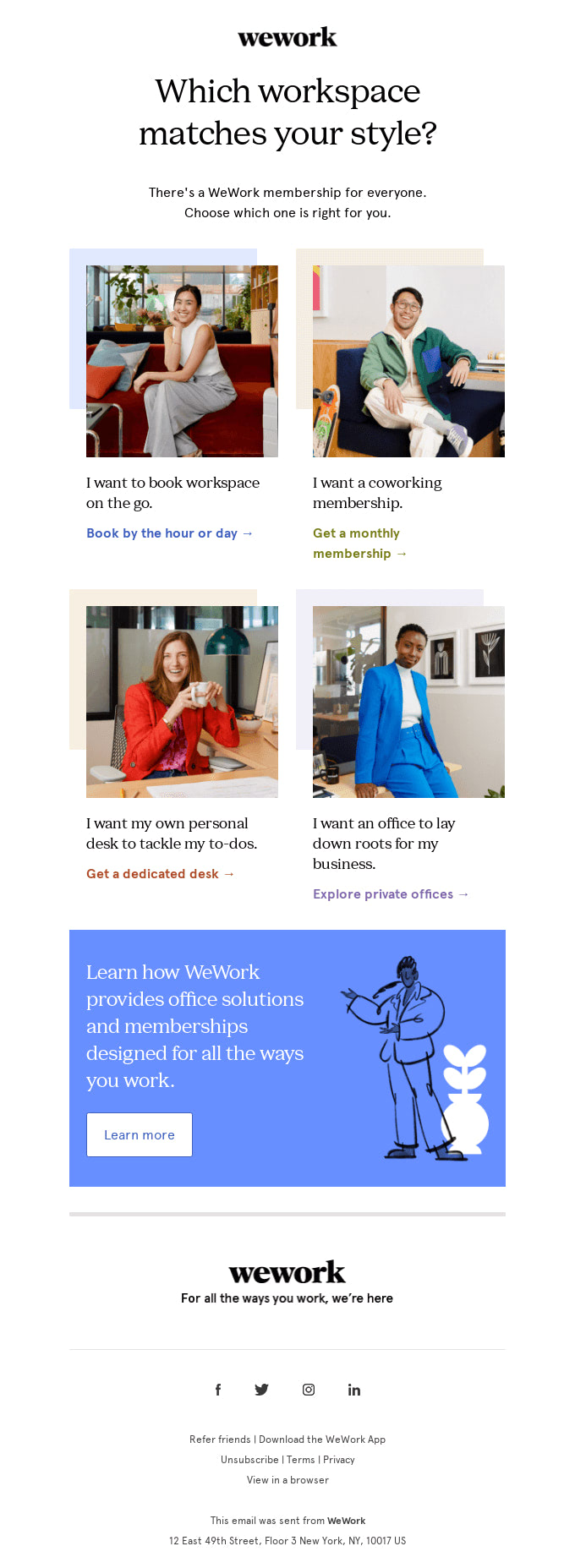
B2C email marketing strategies based on informative emails may pursue different goals. This creates meaningful communication between the company and its customers to inspire loyalty and trust.
In a nutshell, the email aims to educate the audience about membership. It features short descriptions of basic plans and crucial links for more information. At the same time, it builds trust by demonstrating the company’s commitment to providing clients with the best experience. Unlike most such emails, it is not a long read. It is compact and concise, yet it gets straight to the point and delivers value.
The email design is well-structured and pretty neutral. It perfectly accommodates all the information, provides a comfortable reading experience, and makes the company feel professional.
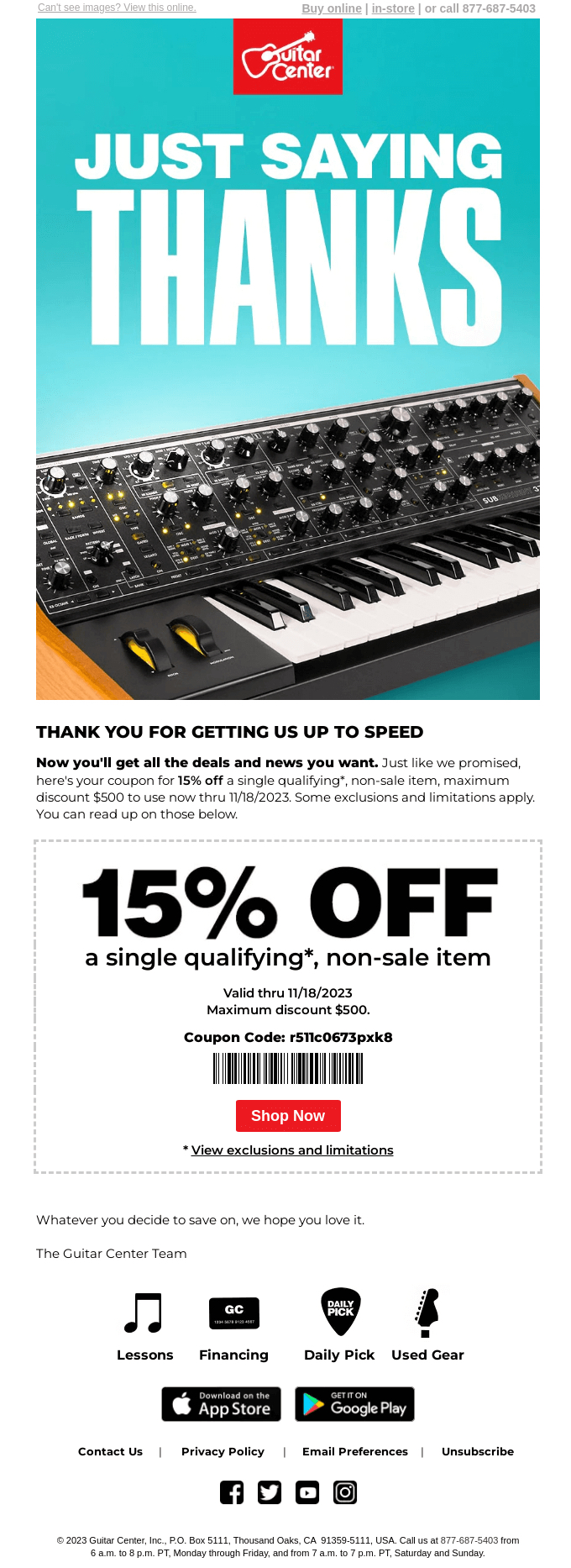
This email from GuitarCenter proves how a typical transactional email can power up a high-converting B2C email marketing strategy and amplify efforts to generate traffic and conversions.
The team has exploited the potential of the first encounter and impression. They have taken basic welcome emails to the next level by demonstrating their gratitude with a “thank you” and personalized 15% discount.
Although this incentive is not stark, it yields great results, as people feel more appreciated in words and actions. This motivates them to check out the company again and consider making another purchase.
Note the email design, as it plays a crucial role in intensifying the message’s impact. It is compact, almost oversimplified, and features only words of gratitude, but this is needed to make the offer the center of attention. The atmosphere is friendly and inviting. Eye-pleasing coloring, optimal readability, and authentic imagery produce a powerful impression.
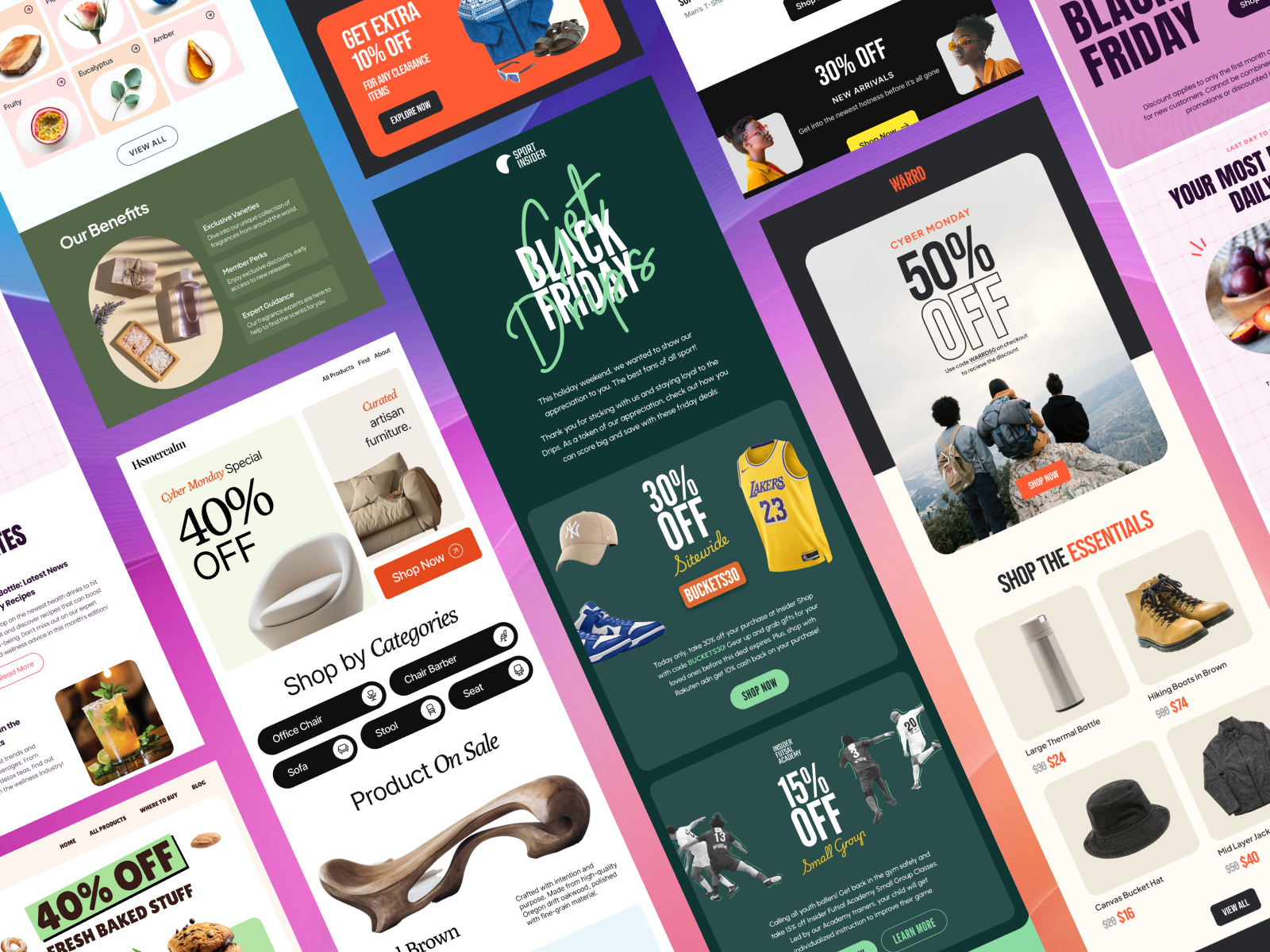
Black Friday Emails by Designmodo
Among all sales events during the year, Black Friday is one of the most important for companies across niches. Invented to increase revenue, it provides a solid foundation for future growth. Another good news is that it is that rare occasion when businesses are welcome to shamelessly bombard their customers with discounts and special offers, as everyone expects.
The only challenge is people receive hundreds of promotional emails during this period, so the competition is tough. It is not enough to develop a perfect pitch and deals; you should be the most catchy and interesting to stand out and encourage customers to engage. This is where email design may help you.
Eye-catching, professional, and compelling, it maximizes a short customer’s attention span, draws attention to the most critical elements of the offer, and leaves a lasting impression. Here are some fantastic email templates that you can utilize to elevate your B2C email marketing strategy for the Black Friday event.

Headset. Nothing screams Black Friday like this fantastic email template. It is dark and mysterious, sparking curiosity and tickling the customer’s imagination. It naturally drives engagement and increases brand exposure.

GoBrash. This spooktacular email template takes a less vibrant but effective approach to lure customers into Black Friday craziness. It fits many niches, from health to food, with its bold hero section, prominent CTA, informative blocks, and authentic design.

Sport Insider. No tricks, just treats – if you want to establish a positive atmosphere and show your friendly personality, this template is just for you. Vibrant colors, impressive hero areas, eye-catching product showcases, and strategically placed offers and CTAs naturally engage an audience and motivate them to visit the website, leaving a favorable impression.
Conclusion
B2C email marketing offers a unique and direct channel to engage with customers, build meaningful relationships, and drive conversions. By implementing the right strategies—personalization, segmentation, and automation—you can create campaigns that resonate with your audience and deliver measurable results. However, it’s not just about sending emails; it’s about understanding your customers’ needs and delivering value with every message.
As you refine your email marketing efforts, focus on continuous testing, learning, and adapting to new trends to stay ahead of the competition. With the right approach, B2C email marketing can become a cornerstone of your brand’s digital success, helping you foster loyalty and achieve sustainable growth.
B2C email marketing is essential for a company’s successful growth. It drives engagement, nurtures customers into the sales funnel, generates revenue, reinforces relationships, and builds a strong brand identity. While it has several serious challenges, with the right tools and a well-thought-out plan, businesses may overcome them without much sacrifice.
When adopting B2C email marketing strategies, companies should know their capacity, target audience’s needs, and trends. They should equip themselves with reliable tools, devise a well-thought-out strategy, implement best practices, and constantly adapt to their target audience’s ever-changing nature.
The last thing to remember is that B2C email marketing is integral to digital marketing; therefore, it must be synchronized and aligned with other efforts to achieve omnichannel consistency and coherency.
